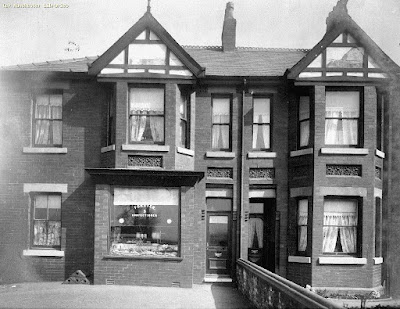This is Brook Lane in 1909 on the cusp of a change.
 |
| 1909 |
For centuries it had led out of the village past the old Bowling Green Hotel, crossed Chorlton Brook, past Brook Farm, and petered out in several footpaths, one of which twisted off towards Hardy Lane.
But in the spring of 1909 the eastern side of the lane was being developed by a row of new houses, which faced the entrance to the sewage works, and the home of Charles Hall the manager of the works.
In the distance there is still open land which within a year and bit will be filled with the new Chorltonville estate, while the new brick sides of the bridge over the brook have yet to replace the low stone wall and to the right the scene is dominated by the farm buildings of Charles Cookson who lived in Brook Farm.
 |
| 1911 |
The new row of houses bears closer inspection, because the first is being constructed to accommodate a shop, and later photographs show that it was occupied by Mrs. Harrier Forster whose window announced that it was a confectioners, and given that it was the only shop in the row of ten properties I guess she sold a few other “essential” items.
And at the beginning of 1910, Mrs. Forster’s neighbours included a joiner, two engineers, a waiter, and a designer along with two clerks and an architect.
In time I will trawl the census returns to find out more about these residents and the lives of Charles Cookson and Charles Ball.
 |
| 1910 |
For now I will just add the remaining three images , one looking back towards the new Bowling Green Hotel showing the club house, and two looking up the lane.
What makes these two interesting is that they qualify as then and now pictures.
The first, as the shop is still yet to be finished, and before the ville was built, and the other with Mrs. Foster in residence and the new estate in place.
Together they offer up a series of images of where we live as the township continued on its journey from a small rural community to a large urban settlement on the edge of Manchester.
 |
| 1910 |

A fascinating set of pictures and an equally fascinating commentary. I look forward to the next instalment!
ReplyDeleteIt’s noticeable how few trees there were in the area back then due to the agricultural use of the land
ReplyDeleteGreat information and photos, thank you
ReplyDeleteThe road on which I've lived for 39 years!
ReplyDelete